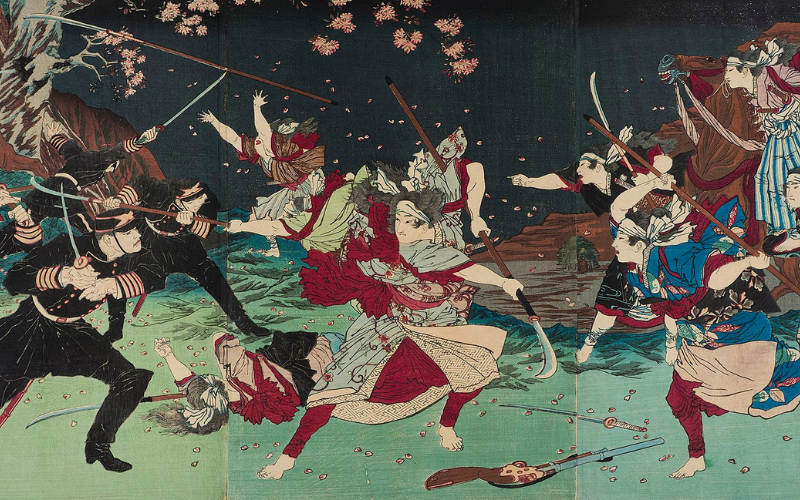Long before the world viewed samurai as exclusively male, women trained in the same combat skills and battle strategies. These Onna-Bugeisha mastered self-defense and offensive maneuvers, wielding weapons with precision. Their weapon of choice was the naginata, a long polearm designed to accommodate their smaller stature while offering superior balance and reach.
For centuries, these female warriors stood shoulder to shoulder with their male counterparts, proving themselves in battle.
Empress Jingu
One of Japan’s earliest known Onna-Bugeisha was Empress Jingu, a warrior queen who, in 200 AD, led a military campaign to conquer Korea. Despite living in a society where women were expected to remain caretakers and subservient to men, Jingu broke the mold.
Her tactical brilliance and leadership won her a place in history, setting a precedent for future generations of female samurai. She defied expectations, proving that women could lead warriors into battle—and win.
Tomoe Gozen
If Empress Jingu was a trailblazer, Tomoe Gozen was a battlefield legend. Between 1180 and 1185, the Genpei War raged between two powerful clans, the Minamoto and the Taira. The Minamoto’s eventual victory might not have been possible without Tomoe Gozen, one of Japan’s most skilled warriors.
Gozen excelled in archery, swordsmanship, and horseback riding. She wielded a katana with deadly precision and commanded troops with unwavering authority. Her reputation as both a warrior and strategist spread quickly, earning her the title of Japan’s first female general.
In 1184, she led 300 samurai against 2,000 Taira warriors—and was one of only five who survived. Later, during the Battle of Awazu, she single-handedly defeated the enemy’s greatest warrior, Honda no Moroshige, beheading him and keeping his head as a trophy.
What happened to Tomoe Gozen after the battle remains a mystery. Some say she fought to the death. Others claim she escaped on horseback, taking her enemy’s head with her. Another tale suggests she married a fellow samurai and later became a nun.
The Rise and Fall of the Onna-Bugeisha
For centuries, female warriors like Tomoe Gozen thrived. Onna-Bugeisha defended villages, trained future generations, and proved themselves on the battlefield. Samurai clans across Japan included women among their ranks, ensuring they were prepared to fight when needed.
But as time passed, war shifted, and the role of the Onna-Bugeisha faded—until one final stand reignited their legacy.
Nakano Takeko
By 1868, Japan was in turmoil. A power struggle erupted between the ruling Tokugawa Shogunate and the Imperial Court. In response, a group of female warriors called the Joshitai formed, led by 21-year-old Nakano Takeko—the last great Onna-Bugeisha.
Trained from childhood in naginata combat, martial arts, and military strategy, Takeko was both highly educated and highly skilled. When war erupted, she refused to stand aside. Instead, she led her warriors into the Battle of Aizu, fighting alongside male samurai against overwhelming Imperial forces.
In the heat of combat, Takeko and her warriors cut down enemy soldiers in brutal close-quarters combat. But even the most skilled samurai could not stop a bullet. During battle, she was shot in the chest. Knowing her enemies would take her head as a trophy, she made one final request—she asked her sister to behead her before the enemy could claim her corpse.
Her sister honored her wish, burying her head beneath a pine tree at Aizu Bangemachi temple. A monument now stands there in her honor.
The End of an Era
Takeko’s death marked the end of the Onna-Bugeisha. Soon after, the Imperial Court seized power, and the samurai class was abolished.
Despite their disappearance from history, female warriors continued to fight throughout the 1800s, challenging gender norms and proving that women could be just as formidable as men. However, as Japan modernized, the world began rewriting samurai history—turning them into exclusively male figures, while the Onna-Bugeisha faded into obscurity.
Don’t forget to tune in…
If you’ve enjoyed this article, there are also articles on Milunka Savić, the most decorated woman soldier in history.
Or my story about the shieldmaiden Viking women.
You can now tune in to the full audio version of this week’s blog here Bells Books Blog Podcast, or it is now available on Amazon Music/Audible, Apple Podcasts, Castbox, Deezer, iHeart Radio, JioSaavn, Podcast Addict, Podchaser, Spotify, and Spreaker.
Thank you for joining me in this week as we honor some of the world’s greatest women warriors.
I encourage you to sign up for my weekly blog. When you do so you will get a free copy of Yesteryear’s Ruin, the prequel to my new Case 47 series.
Until next time, keep your curiosity alive and your imagination ignited— and as always, keep the past alive!





 “Yesteryear’s Ruin” captures the essence of human resilience in the face of unimaginable loss. Through a narrative that weaves together love, despair, and the quest for redemption, this historical psychological thriller invites readers into a world where the past is not merely a memory, but a realm that may hold the key to our deepest desires and darkest fears.
“Yesteryear’s Ruin” captures the essence of human resilience in the face of unimaginable loss. Through a narrative that weaves together love, despair, and the quest for redemption, this historical psychological thriller invites readers into a world where the past is not merely a memory, but a realm that may hold the key to our deepest desires and darkest fears.